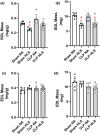The impact of hindlimb disuse on sepsis-induced myopathy in mice
- PMID: 34309237
- PMCID: PMC8311555
- DOI: 10.14814/phy2.14979
The impact of hindlimb disuse on sepsis-induced myopathy in mice
Abstract
Sepsis induces a myopathy characterized by loss of muscle mass and weakness. Septic patients undergo prolonged periods of limb muscle disuse due to bed rest. The contribution of limb muscle disuse to the myopathy phenotype remains poorly described. To characterize sepsis-induced myopathy with hindlimb disuse, we combined the classic sepsis model via cecal ligation and puncture (CLP) with the disuse model of hindlimb suspension (HLS) in mice. Male C57bl/6j mice underwent CLP or SHAM surgeries. Four days after surgeries, mice underwent HLS or normal ambulation (NA) for 7 days. Soleus (SOL) and extensor digitorum longus (EDL) were dissected for in vitro muscle mechanics, morphological, and histological assessments. In SOL muscles, both CLP+NA and SHAM+HLS conditions elicited ~20% reduction in specific force (p < 0.05). When combined, CLP+HLS elicited ~35% decrease in specific force (p < 0.05). Loss of maximal specific force (~8%) was evident in EDL muscles only in CLP+HLS mice (p < 0.05). CLP+HLS reduced muscle fiber cross-sectional area (CSA) and mass in SOL (p < 0.05). In EDL muscles, CLP+HLS decreased absolute mass to a smaller extent (p < 0.05) with no changes in CSA. Immunohistochemistry revealed substantial myeloid cell infiltration (CD68+) in SOL, but not in EDL muscles, of CLP+HLS mice (p < 0.05). Combining CLP with HLS is a feasible model to study sepsis-induced myopathy in mice. Hindlimb disuse combined with sepsis induced muscle dysfunction and immune cell infiltration in a muscle dependent manner. These findings highlight the importance of rehabilitative interventions in septic hosts to prevent muscle disuse and help attenuate the myopathy.
Keywords: atrophy; infection; inflammation; muscle; septic shock; weakness.
© 2021 The Authors. Physiological Reports published by Wiley Periodicals LLC on behalf of The Physiological Society and the American Physiological Society.
Conflict of interest statement
Authors declare that they have no conflict of interest to disclose.
Figures







References
-
- Augusto, V. , Padovani, C. R. , & Campos, G. E. R. (2004). Skeletal muscule fiber types in C57BL6J mice. Brazilian Journal of Morphological Science 21, 89–94.
-
- Brakenridge, S. C. , Efron, P. A. , Stortz, J. A. , Ozrazgat‐Baslanti, T. , Ghita, G. , Wang, Z. , Bihorac, A. , Mohr, A. M. , Brumback, B. A. , Moldawer, L. L. , & Moore, F. A. (2018). The impact of age on the innate immune response and outcomes after severe sepsis/septic shock in trauma and surgical intensive care unit patients. Journal of Trauma and Acute Care Surgery, 85, 247–255. 10.1097/TA.0000000000001921 - DOI - PMC - PubMed
Publication types
MeSH terms
Grants and funding
LinkOut - more resources
Full Text Sources
Medical
Miscellaneous

